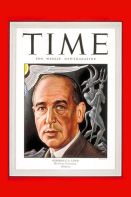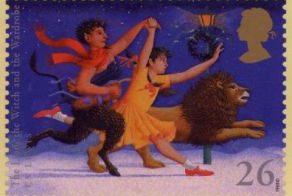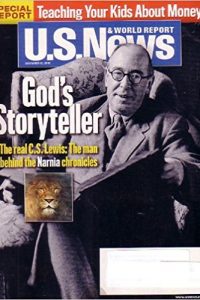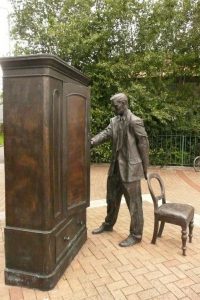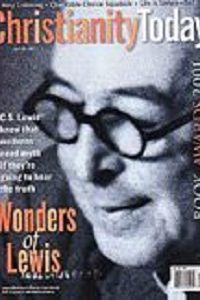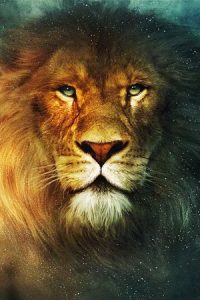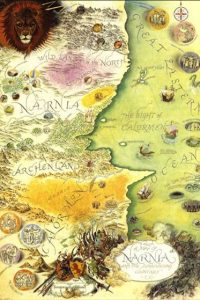
Further Information
With the enormous success of C.S. Lewis’s bestselling books, his huge following among Oxford University students, and at the time of the release of his book Miracles , Time magazine featured Lewis with the cover article, “Oxford’s C.S. Lewis: His Heresy: Christianity.” The article states that “With erudition, good humor and skill, Lewis is writing about religion for a generation of religion-hungry readers brought up on a diet of ‘scientific’ jargon and Freudian clichés. . . . Lewis (like T. S. Eliot, W. H. Auden, et al.) is one of a growing band of heretics among modern intellectuals: an intellectual who believes in God.” The article goes on to note the envy and academic bigotry Lewis had to endure at Oxford: “Outside his own Christian circle, Lewis is not particularly popular with his Oxford colleagues. Some resent his large student following. Others criticize his ‘cheap’ performances on the BBC and sneer at him as a ‘popularizer.’ . . . their most serious charge is that Lewis’ theological pamphleteering is a kind of academic heresy. On this score, one of Lewis’ severest critics insists that his works of scholarship, The Allegory of Love (on [Edmund] Spenser), and A Preface to Paradise Lost, are ‘miles ahead’ of any other literary criticism in England. But Lewis’ Christianity, says his critic, has brought him more money than it ever brought Joan of Arc, and a lot more publicity than she enjoyed in her lifetime.” The article notes that “That audience is the result of Lewis’ special gift for dramatizing Christian dogma. He would be the last to claim that what he says is new; but, like another eloquent and witty popularizer of Christianity, the late G.K. Chesterton, he has a talent for putting old-fashioned truths into a modern idiom.”
The Chronicles of Narnia: The Voyage of the Dawn Treader
Released on June 17th, Walden Media has just released the official trailer for the forthcoming, major film based on C.S. Lewis’s, The Voyage of the Dawn Treader, the third book in The Chronicles of Narnia series. Scheduled for release on December 10, 2010, the film is directed by Michael Apted and stars Ben Barnes (Caspian X, King of Narnia), Skandar Keynes (Edmund Pevensie), Georgie Henley (Lucy Pevensie), and Will Poulter (Eustace Scrubb). The film follows on the previous two films, The Lion, the Witch and the Wardrobe (2005) and Prince Caspian (2008). Here is additional background on the book, The Voyage of the Dawn Treader, and here is the official web site for the forthcoming film.
The Chronicles of Narnia: Prince Caspian
Of all of C.S. Lewis’s many works, the 7-volume Chronicles of Narnia book series is by far and away the most popular with sales of more than 100 million copies worldwide. The first film in the new series being produced by Walden Media and Walt Disney Productions, The Lion, the Witch and the Wardrobe, grossed $740 million in box office sales and additional record DVD sales. The second film in the Narnia series, Prince Caspian, released on May 16, 2008, grossed $420 million, with the C.S. Lewis Society of California hosting an exclusive private screening and luncheon event in San Francisco. Here is the trailer, here is the official Prince Caspian movie poster, and here is the banner for the film. The next film in the series is The Voyage of the Dawn Treader, currently set for release for Christmas 2010.
C.S. Lewis Centenary Commemorative Stamp
The 1998 C.S. Lewis Centenary Commemorative Stamp from the Royal Mail, marking the centenary of C.S. Lewis’s birth, was issued as part of the “Magical Worlds” set, and was the greatest seller of the set (the others being stamps commemorating Lewis Carroll, J.R.R. Tolkien, Mary Norton, and Edith Nesbit). Designed by Peter Malone, the stamp shows Mr. Tumnus and Lucy, hand-in-hand, running with Aslan over snow, in front of the lamp-post, with wording in the left-hand margin reading “The Lion, the Witch, and the Wardrobe C.S. Lewis.” The denomination of the stamp is 26p, First Class Internal Post, inside the United Kingdom. The stamp’s date of issue was July 21, 1998.
U.S. News & World Report Cover Featuring C.S. Lewis, December 12, 2005
This special issue coincided with the theatrical release of the Disney/Walden Media film version of C.S. Lewis’s book, The Lion, the Witch and the Wardrobe, and features the cover article, “God’s Storyteller: The curious life and prodigious influence of C. S. Lewis, the man behind The Chronicles of Narnia,” by Jay Tolson.
C.S. Lewis “Searcher Centenary Sculpture”
“The Searcher Centenary Sculpture” by Northern Irish artist Ross Wilson is dedicated to the work of C.S. Lewis (1898-1963), who was born in Belfast, Northern Ireland. The sculpture was unveiled on November 6, 1998, and is located at Holywood Arches Library, Holywood Road, in Belfast. In a letter to James O’Fee (Chairman, C.S. Lewis Centenary Group), dated March 25, 1998, Ross Wilson states the following:
Dear James,
The sculpture concept came from a letter that C.S. Lewis wrote to a little girl called Anne Jenkins in 1961. She was upset that Aslan had died (in The Lion, the Witch, and the Wardrobe). She stopped reading and wrote to C.S. Lewis. He replied explaining why Aslan had died and told her to read on, that Aslan came back to life. I discovered this letter while in conversation with Douglas Gresham one day in his study. . . . I was impressed that [Lewis] took time to write back and didn’t write to her as a child but as an important person. . . . I became inspired [by this] reply written over 37 years ago. I have traced and found Anne Jenkins, almost 50 years old now. She could not believe the events that are now beginning to unfold. She plans to attend the sculpture unveiling. The letter will be reproduced in bronze on the back of the wardrobe, people will not only be able to look at the sculpture but read the words of Lewis himself explaining the need to find Aslan and the meaning behind The Chronicles of Narnia; Lewis still speaking after all these years, The image of the man walking towards the wardrobe is a stylized heroic image of C.S. Lewis representing the searcher: an almost ‘everyman’ setting out to find Aslan. I hope it will be seen as a pointer as well, to show that sometimes the greatest things can be found in the unlikeliest of places, a wardrobe, a world beyond a wardrobe. The finished figure will hold a chair and not a book. The chair may be used as a vehicle of transport; as the viewer is seated on the bronze chair they travel through Lewis via imagination to Narnia. A way of helping people to re-view things. . . . I hope this helps.
Best, Ross Wilson
P.S. This is precisely what Christianity is about. “This world is a great sculptor’s shop. We are the statues and there is a rumour going round the shop that some of us are some day going to come to life.” —C. S. Lewis
Christianity Today Cover Featuring C.S. Lewis, December 2005
This special Christmas 2005 issue features a number of articles on Lewis, including “C.S. Lewis Superstar” by Bob Smietana and “Into the Wonder” by Alan Jacobs.
The Eagle and Child
Located at 49 St. Giles in Oxford, England, this pub was the weekly haunt of “The Inklings” literary society from 1939 to 1962. The Inklings group shared an interest in Christian narrative fiction and regularly included C.S. Lewis, J.R.R. Tolkien, Charles Williams, Owen Barfield, Christopher Tolkien, Warren Lewis, Hugo Dyson, Roger Lancelyn Green, Adam Fox, Robert Havard, J.A.W. Bennett, Lord David Cecil, and Nevil Coghill. Other less frequent attendees included Percy Bates, Charles Leslie Wrenn, Colin Hardie, James Dundas-Grant, John Wain, R.B. McCallum, Gervase Mathew, C.E. Stevens, and Eric Rücker Eddison. The group met every Monday or Friday before lunch to drink and talk in what became the Rabbit Room. Separately, readings and discussions of the members’ unfinished works were usually held Thursday evenings in C.S. Lewis’s rooms at Magdalen College, Oxford University. Tolkien’s The Lord of the Rings, Lewis’s Out of the Silent Planet, and Williams’s All Hallows’ Eve were among the many novels and other writings first read to the Inklings. According to Lewis’s brother Warren, “Properly speaking, the Inklings was neither a club nor a literary society, though it partook of the nature of both. There were no rules, officers, agendas, or formal elections.” The pub itself was originally opened in 1650 and was nicknamed “The Bird and Baby.”
Aslan, the King of Narnia
Aslan (meaning “lion” in Turkish), “The Greatest Lion,” is the central “Christ-like” character in C.S. Lewis’s seven-volume book series, The Chronicles of Narnia. Aslan is a talking lion, son of the Emperor-Over-the-Sea, who is wise, compassionate, mysterious, and beloved. He is the creator and guardian of Narnia. Although he is gentle and loving, Aslan is also powerful, dangerous and “Not a tame lion.” According to C.S. Lewis, “If Aslan represented the immaterial Deity, he would be an allegorical figure. In reality however he is an invention giving an imaginary answer to the question, What might Christ become like if there really were a world like Narnia and He chose to be incarnate and die and rise again in that world as He actually has done in ours? This is not allegory at all.”
Map of the Land of Narnia
In her mid-twenties, Pauline Baynes became the illustrator of the seven books in The Chronicles of Narnia series. She originally drew hundreds of wonderfully detailed black-and-white line drawings for the books. And in 1998 she added color to every one of the approximately 350 original drawings, and these are the illustrations found today. This beautiful map by her of the land of Narnia was published in 1972.
The Screwtape Letters: Adapted for the Stage
C. S. Lewis’s brilliant, bestselling novel, The Screwtape Letters, explores the theme of spiritual warfare from a demon’s point of view. This funny, provocative and wickedly witty theatrical adaptation—critically acclaimed in New York; standing room only at the Shakespeare Theatre in Washington D.C.; and called the “most successful show in the history of the Chicago Mercury Theater” by the Chicago Tribune—stars Max McLean as Screwtape. This program is adapted for the stage by Jeffrey Fiske and Max McLean, directed by Jeffrey Fiske, and produced ay the Fellowship for the Performing Arts.

